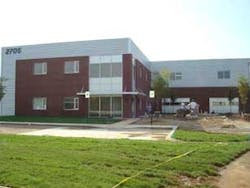AquaShield Showcases Systems in Corporate Office Expansion
AquaShield stepped into the shoes of its customers when the firm decided to expand its corporate offices. Working with a blank canvas for a new building and site design, the Chattanooga, Tenn.-based manufacturer of storm water treatment systems saw an opportunity to underscore its faith in its products by putting them to work at the company's new flagship facility.
"We are well aware of what we can do to treat storm water runoff, and we wanted to incorporate cutting-edge water management technologies into our building plans," said AquaShield President J. Kelly Williamson.
The company had enjoyed its urban location for seven years, but when a parcel of land next door became available, the time was ripe for expansion. The site is similar to those the firm's customers deal with all the time; it had a major utility easement running through and faced a need for extensive filling and grading.
Tennessee, like much of the Southeast, is in the midst of a severe drought. Normally, Chattanooga receives about 54 in. of rain annually. When construction began on the new office in 2007, the city had a 14-in. rainfall deficit for the year.
Despite the dry conditions, the company wanted to include rainwater harvesting, a natural extension of dealing with storm water. The design called for storing the equivalent water volume of a 100-year storm for some building operations as well as landscape irrigation.
Faced with the site demands, modular polypropylene storm water tanks were a perfect fit to store storm water after it had been pretreated with company products. "Going underground with rainwater storage will pay dividends in the long run, and we will be grateful we banked this land for future use," Williamson said.
The new corporate headquarters is designed and constructed according to U.S. Green Building Council Leadership in Energy and Environmental Design standards. "Building in an urban environment does not have to be just cold steel and concrete," Williamson said. "You can include design elements that are not only environmentally responsible but also allow you to take advantage of other opportunities if you understand how nature deals with the ebb and flow of rainfall."
Source: AquaShield Inc.


